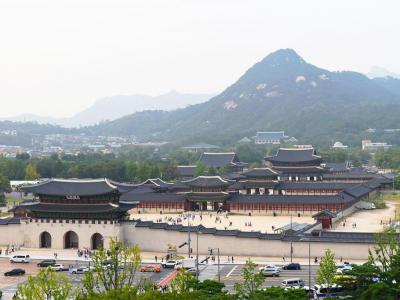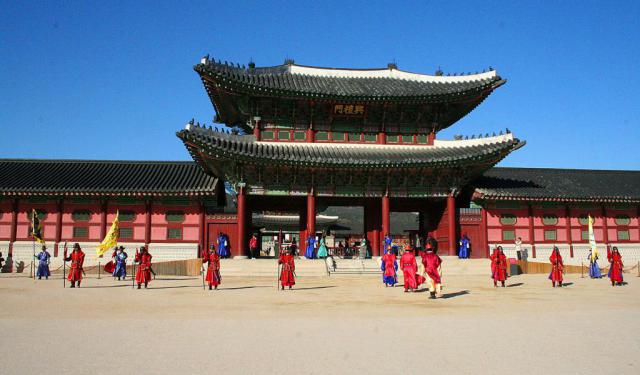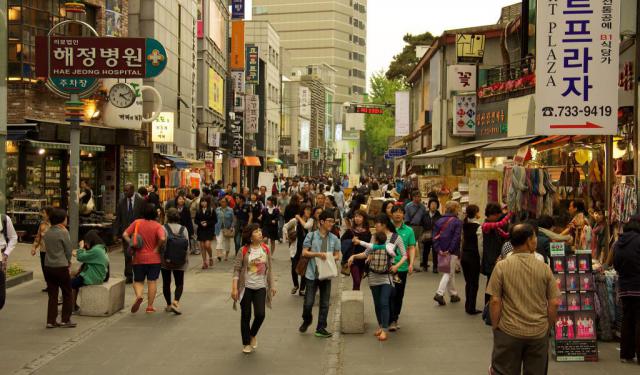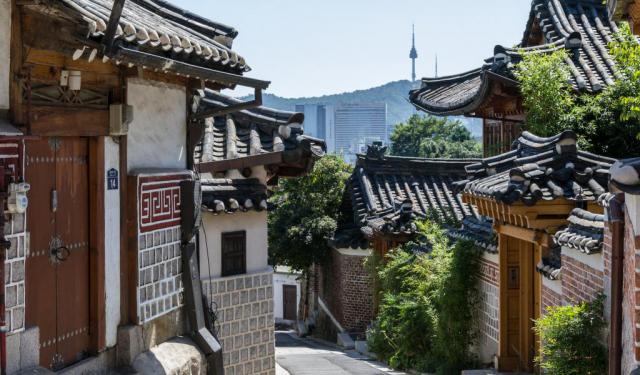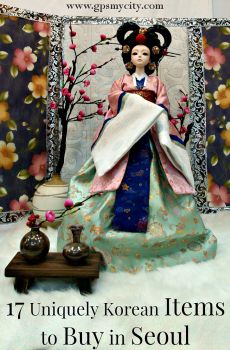Gyeongbokgung Palace, Seoul (must see)
Gyeongbokgung Palace was built in 1395 by the Joseon Dynasty. This impressive complex served as the Joseon Dynasty's main palace and is the largest of the Five Grand Palaces.
It was destroyed by fire during the Imjin War in 1592 and sat abandoned for over two centuries. In 1867, the palace was reconstructed with 330 buildings and 5,792 rooms. In 1895, Japanese agents assassinated Empress Myeongseong. Emperor Gojong, her husband, left the palace and never returned.
In the early 20th century, Japan's colonial government destroyed palace buildings and constructed the enormous Japanese General Government Building outside the throne hall.
Only a few 19th-century buildings survived the Japanese government and the Korean War. These buildings include Geunjeongjeon (the Imperial Throne Hall), Hyangwonjeong Pavilion, Gyeonghoeru Pavilion, Sujeongjeon Hall, Jagyeongjeon Hall, Sajeongjeon Hall, and Jibokjae Hall.
In 1989, reconstruction began to restore the palace to its former glory. About 40 percent of the building have since been reconstructed or restored.
Geunjeongjeon, the Imperial Throne Hall, is truly impressive. Its constructed mainly of wood and sits in a courtyard lined with stones. Known as rank stones, they indicated where officials of different ranks could stand during ceremonies. The entire courtyard is cloistered.
Gyeongbokgung Palace features dozens of architecturally interesting buildings. Hyangwonjeong, a beautiful hexagonal pavilion, sits attractively on an island.
Why You Should Visit:
Gyeongbokgung Palace is the largest and grandest of the Five Grand Palaces. Visit the National Folk Museum of Korea on the palace grounds to learn about the history of the Korean people. The National Palace Museum of Korea is also located on the palace grounds and houses priceless 14th century Joseon dynasty treasures.
Tips:
You can rent traditional costumes to immerse yourself in 14th-century royal Korea.
For a memorable experience, sign up for a night tour and see the palace lit up. Gyeonghoeru looks spectacular as its warm lights are reflected in the pond.
For a once in a lifetime experience, take part in a Gyeongbokgung Royal Dining event. Sample royal food and watch a traditional performance.
It was destroyed by fire during the Imjin War in 1592 and sat abandoned for over two centuries. In 1867, the palace was reconstructed with 330 buildings and 5,792 rooms. In 1895, Japanese agents assassinated Empress Myeongseong. Emperor Gojong, her husband, left the palace and never returned.
In the early 20th century, Japan's colonial government destroyed palace buildings and constructed the enormous Japanese General Government Building outside the throne hall.
Only a few 19th-century buildings survived the Japanese government and the Korean War. These buildings include Geunjeongjeon (the Imperial Throne Hall), Hyangwonjeong Pavilion, Gyeonghoeru Pavilion, Sujeongjeon Hall, Jagyeongjeon Hall, Sajeongjeon Hall, and Jibokjae Hall.
In 1989, reconstruction began to restore the palace to its former glory. About 40 percent of the building have since been reconstructed or restored.
Geunjeongjeon, the Imperial Throne Hall, is truly impressive. Its constructed mainly of wood and sits in a courtyard lined with stones. Known as rank stones, they indicated where officials of different ranks could stand during ceremonies. The entire courtyard is cloistered.
Gyeongbokgung Palace features dozens of architecturally interesting buildings. Hyangwonjeong, a beautiful hexagonal pavilion, sits attractively on an island.
Why You Should Visit:
Gyeongbokgung Palace is the largest and grandest of the Five Grand Palaces. Visit the National Folk Museum of Korea on the palace grounds to learn about the history of the Korean people. The National Palace Museum of Korea is also located on the palace grounds and houses priceless 14th century Joseon dynasty treasures.
Tips:
You can rent traditional costumes to immerse yourself in 14th-century royal Korea.
For a memorable experience, sign up for a night tour and see the palace lit up. Gyeonghoeru looks spectacular as its warm lights are reflected in the pond.
For a once in a lifetime experience, take part in a Gyeongbokgung Royal Dining event. Sample royal food and watch a traditional performance.
Want to visit this sight? Check out these Self-Guided Walking Tours in Seoul. Alternatively, you can download the mobile app "GPSmyCity: Walks in 1K+ Cities" from Apple App Store or Google Play Store. The app turns your mobile device to a personal tour guide and it works offline, so no data plan is needed when traveling abroad.
Gyeongbokgung Palace on Map
Sight Name: Gyeongbokgung Palace
Sight Location: Seoul, South Korea (See walking tours in Seoul)
Sight Type: Attraction/Landmark
Guide(s) Containing This Sight:
Sight Location: Seoul, South Korea (See walking tours in Seoul)
Sight Type: Attraction/Landmark
Guide(s) Containing This Sight:
Walking Tours in Seoul, South Korea
Create Your Own Walk in Seoul
Creating your own self-guided walk in Seoul is easy and fun. Choose the city attractions that you want to see and a walk route map will be created just for you. You can even set your hotel as the start point of the walk.
Seoul Introduction Walking Tour
The bustling capital of South Korea, Seoul, seamlessly blends modern innovation with a more than 2,000-year history. Remarkably, until 1972, the city was claimed by North Korea as its de jure capital and even specified as such in its constitution.
Seoul was founded in 18 BC by the people of Baekje. The three ancient kingdoms of Korea – Baekje, Goguryeo, and Silla – fought over its... view more
Tour Duration: 2 Hour(s)
Travel Distance: 3.5 Km or 2.2 Miles
Seoul was founded in 18 BC by the people of Baekje. The three ancient kingdoms of Korea – Baekje, Goguryeo, and Silla – fought over its... view more
Tour Duration: 2 Hour(s)
Travel Distance: 3.5 Km or 2.2 Miles
Insa-dong Walking Tour
Originating 500 years ago as a residential quarter for government officials, today's Insa-dong is a buzzing shopping and dining district in Seoul where the past meets the present. During the Japanese occupation of the country in the first half of the 20th century, wealthy Koreans were forced to move out and sell their belongings, at which point the district became a center of antique trading.... view more
Tour Duration: 1 Hour(s)
Travel Distance: 0.8 Km or 0.5 Miles
Tour Duration: 1 Hour(s)
Travel Distance: 0.8 Km or 0.5 Miles
Bukchon Hanok Village Walk
Bukchon Hanok, the traditional Korean village in downtown Seoul, is famous for its well-preserved 600-year-old setting. Once home to the nation’s nobility, the village sits on a hill near the Changdeokgung Palace.
One notable attraction here is Baek In-je's House Museum, which provides insight into the life of a prominent Korean politician from the early 20th century. Meanwhile, the... view more
Tour Duration: 1 Hour(s)
Travel Distance: 1.7 Km or 1.1 Miles
One notable attraction here is Baek In-je's House Museum, which provides insight into the life of a prominent Korean politician from the early 20th century. Meanwhile, the... view more
Tour Duration: 1 Hour(s)
Travel Distance: 1.7 Km or 1.1 Miles
Useful Travel Guides for Planning Your Trip
17 Uniquely Korean Souvenirs to Buy in Seoul
Back in the mid 20th century, a certain gentleman once spoke of Korea saying, it won't be possible to grow a rose in a waste bin. Certainly, one would hardly subscribe to his point of view today in every respect, given the image of contemporary South Korea and its capital city of Seoul in...
